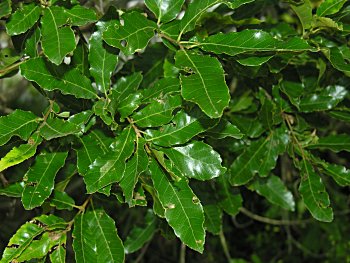Sawtooth Oak Tree
Category: Deciduous Trees

Facts about Sawtooth Oak Tree, "Scientific name for Sawtooth Oak Tree is Quercus acutissima". The sawtooth oak is also known as the Quercus acutissima. The Sawtooth Oak Tree is a deciduous, medium-sized oak which is native to Korea, Japan and China. However, it is presently found in other countries like North America. The Sawtooth Oak Tree comes from a genus family with shoot buds which are characterized with leaf lobes, soft bristle and acorns. The deciduous oak can grow into a round, pyramidal, cone-like shape reaching a height of up to 65 to 100 feet (20 to 30 meters) with a spread of 35 to 50 feet (10.66 to 15.24 meters) and trunk size of 6 1/2 feet (2 meters).
The Sawtooth Oak Tree has a deeply furrowed, dark gray bark and green foliage's which are characterized with fourteen to twenty saw-teeth like, small lobed leaves which can establish up to a length of about 3 1/8 to 7 7/8 inches (8 to 20 cm) with a spread of 1 1/8 to 2 1/4 (3 to 6 cm). The Sawtooth Oak Tree’s flowers, catkins, are pollinated to develop fruits, acorn, which takes eight months before they mature. Upon maturity these acorns can be around 7/8 to 1 1/8 inches (2 to 3 cm) long and (2 cm) wide. The acorns have a cupped-shape wrapping which can wrap the entire surface of the fruit. These covering can be one to 7/8 inches (2 cm) in depth and it is also covered in four to eight millimeters long, soft bristles. The Sawtooth Oak Tree fruits usually fall in mid September.
Sawtooth Oak Tree leaves are made up of many colored pigments, green chlorophyll hides the colors during the growing season of spring and summer. As days get Shorter and cooler temperatures come in the fall, it cause the chlorophyll to break down and than the other color pigments can be seen.
Sawtooth Oak Tree growth is referred to as Meristem (The undifferentiated embryonic plant tissue from which new cells are created, as that at the tip of a root or stem). This tissue can be found at the tips of shoots and leaves. Inside the stem growth in thickness occurs at the vascular cambium.
The Sawtooth Oak Tree has a moderate growth rate and it can establish well in USDA zones of five to nine. It can do well in a variety of soil conditions including loam, clay, acidic or slightly alkaline. The Sawtooth Oak Tree requires moderately drained soils and in full sun. It can tolerate dry weather conditions.
A Full grown Sawtooth Oak Tree can absorb as much as 48 pounds (21.77 kg) of carbon dioxide a year. The same Sawtooth Oak Tree could also produce enough oxygen in a day for two people. In a single day, a large Sawtooth Oak Tree can drink up to 100 gallons (378.5 liter) of water from the ground and discharge it into the air.
You can tell a Sawtooth Oak Trees age by the number of growth rings. Growth rings size shows what kind of conditions accrued that year, the temperature and if it was a dry or wet year.
Bark of the Sawtooth Oak Tree protects it from the elements and is made up of dead cells.
Sawtooth Oak Tree roots usually grow two to three times the width of the tree branches. The ideal time to fertilize your Sawtooth Oak Tree is in late fall or early spring. If you want to transplant a Sawtooth Oak Tree do it in fall, this is ideal for most trees.
The Sawtooth Oak Tree is planted in North America in big number for wildlife consumption use by some animal species. The wood produced from the Sawtooth Oak Tree is prone to splits and cracks. This has led to little use of the wood in fencing and construction practices.
Sawtooth Oak Trees make their own food from sunlight, carbon dioxide, water, and nutrients from the soil.

 Back To Category Deciduous Trees
Back To Category Deciduous Trees